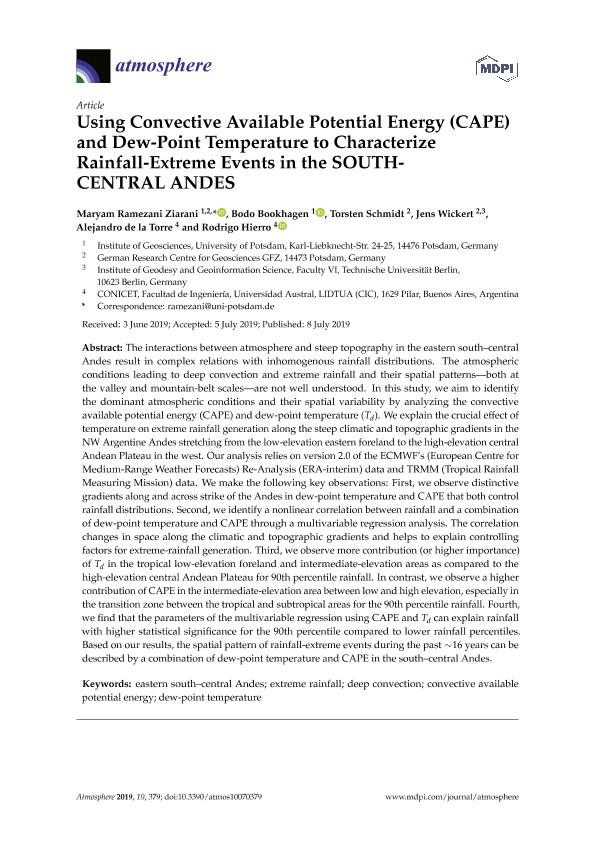Mostrar el registro sencillo del ítem
dc.contributor.author
Ziarani, Maryam Ramezani
dc.contributor.author
Bookhagen, Bodo
dc.contributor.author
Schmidt, Torsten

dc.contributor.author
Wickert, Jens
dc.contributor.author
de la Torre, Alejandro

dc.contributor.author
Hierro, Rodrigo Federico

dc.date.available
2021-04-30T12:14:01Z
dc.date.issued
2019-07-08
dc.identifier.citation
Ziarani, Maryam Ramezani; Bookhagen, Bodo; Schmidt, Torsten; Wickert, Jens; de la Torre, Alejandro; et al.; Using convective available potential energy (CAPE) and dew-point temperature to characterize rainfall-extreme events in the Southcentral Andes; Molecular Diversity Preservation International; Atmosphere; 10; 7; 8-7-2019; 1-22
dc.identifier.issn
2073-4433
dc.identifier.uri
http://hdl.handle.net/11336/131126
dc.description.abstract
The interactions between atmosphere and steep topography in the eastern south-central Andes result in complex relations with inhomogenous rainfall distributions. The atmospheric conditions leading to deep convection and extreme rainfall and their spatial patterns-both at the valley and mountain-belt scales-are not well understood. In this study, we aim to identify the dominant atmospheric conditions and their spatial variability by analyzing the convective available potential energy (CAPE) and dew-point temperature (Td). We explain the crucial effect of temperature on extreme rainfall generation along the steep climatic and topographic gradients in the NW Argentine Andes stretching from the low-elevation eastern foreland to the high-elevation central Andean Plateau in the west. Our analysis relies on version 2.0 of the ECMWF's (European Centre for Medium-RangeWeather Forecasts) Re-Analysis (ERA-interim) data and TRMM (Tropical Rainfall Measuring Mission) data. We make the following key observations: First, we observe distinctive gradients along and across strike of the Andes in dew-point temperature and CAPE that both control rainfall distributions. Second, we identify a nonlinear correlation between rainfall and a combination of dew-point temperature and CAPE through a multivariable regression analysis. The correlation changes in space along the climatic and topographic gradients and helps to explain controlling factors for extreme-rainfall generation. Third, we observe more contribution (or higher importance) of Td in the tropical low-elevation foreland and intermediate-elevation areas as compared to the high-elevation central Andean Plateau for 90th percentile rainfall. In contrast, we observe a higher contribution of CAPE in the intermediate-elevation area between low and high elevation, especially in the transition zone between the tropical and subtropical areas for the 90th percentile rainfall. Fourth, we find that the parameters of the multivariable regression using CAPE and Td can explain rainfall with higher statistical significance for the 90th percentile compared to lower rainfall percentiles. Based on our results, the spatial pattern of rainfall-extreme events during the past ~16 years can be described by a combination of dew-point temperature and CAPE in the south-central Andes.
dc.format
application/pdf
dc.language.iso
eng
dc.publisher
Molecular Diversity Preservation International

dc.rights
info:eu-repo/semantics/openAccess
dc.rights.uri
https://creativecommons.org/licenses/by/2.5/ar/
dc.subject
CONVECTIVE AVAILABLE POTENTIAL ENERGY
dc.subject
DEEP CONVECTION
dc.subject
DEW-POINT TEMPERATURE
dc.subject
EASTERN SOUTH-CENTRAL ANDES
dc.subject
EXTREME RAINFALL
dc.subject.classification
Meteorología y Ciencias Atmosféricas

dc.subject.classification
Ciencias de la Tierra y relacionadas con el Medio Ambiente

dc.subject.classification
CIENCIAS NATURALES Y EXACTAS

dc.title
Using convective available potential energy (CAPE) and dew-point temperature to characterize rainfall-extreme events in the Southcentral Andes
dc.type
info:eu-repo/semantics/article
dc.type
info:ar-repo/semantics/artículo
dc.type
info:eu-repo/semantics/publishedVersion
dc.date.updated
2021-04-22T20:11:19Z
dc.journal.volume
10
dc.journal.number
7
dc.journal.pagination
1-22
dc.journal.pais
Suiza

dc.journal.ciudad
Basel
dc.description.fil
Fil: Ziarani, Maryam Ramezani. Universitat Potsdam. Mathematisch Nautrwissenschaften Fakultat. Institut Fur Geowissenschaften; Alemania. German Research Centre for Geosciences; Alemania
dc.description.fil
Fil: Bookhagen, Bodo. Universitat Potsdam. Mathematisch Nautrwissenschaften Fakultat. Institut Fur Geowissenschaften; Alemania
dc.description.fil
Fil: Schmidt, Torsten. German Research Centre for Geosciences; Alemania
dc.description.fil
Fil: Wickert, Jens. German Research Centre for Geosciences; Alemania. Technishe Universitat Berlin; Alemania
dc.description.fil
Fil: de la Torre, Alejandro. Consejo Nacional de Investigaciones Científicas y Técnicas; Argentina. Universidad Austral. Facultad de Ingeniería. Laboratorio de Investigación Desarrollo y Transferencia - Comisión de Investigaciones Científicas de la Provincia de Buenos Aires. Laboratorio de Investigación Desarrollo y Transferencia; Argentina
dc.description.fil
Fil: Hierro, Rodrigo Federico. Consejo Nacional de Investigaciones Científicas y Técnicas; Argentina. Universidad Austral. Facultad de Ingeniería. Laboratorio de Investigación Desarrollo y Transferencia - Comisión de Investigaciones Científicas de la Provincia de Buenos Aires. Laboratorio de Investigación Desarrollo y Transferencia; Argentina
dc.journal.title
Atmosphere
dc.relation.alternativeid
info:eu-repo/semantics/altIdentifier/doi/http://dx.doi.org/10.3390/atmos10070379
dc.relation.alternativeid
info:eu-repo/semantics/altIdentifier/url/https://www.mdpi.com/2073-4433/10/7/379
Archivos asociados
